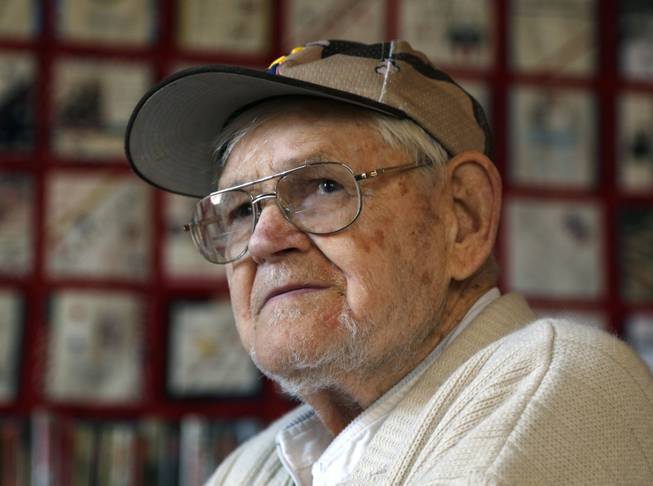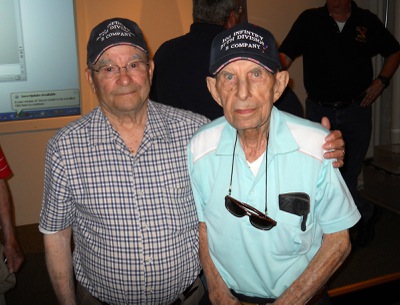
Mike Groll / AP
World War II veteran Arthur Robinson of Saratoga Springs, N.Y., poses at the New York State Military Museum on Thursday, May 8, 2014, in Saratoga Springs. The Army’s 27th Infantry Division, which Robinson served in, bore the brunt of Japan’s largest mass suicide attack, launched before dawn on July 7, 1944, on the island of Saipan. The division’s 105th Regiment saw more than 400 killed and 500 wounded during the attack by more than 3,000 Japanese soldiers and sailors. The 27th was a former New York National Guard unit that still had many New Yorkers among its ranks when it landed on Saipan after the U.S. Marines made the initial beach assault on June 15, 1944.
Monday, July 7, 2014 | 2 a.m.

World War II veterans Wilfred "Spike" Mailloux, left, and John Sidur, both of Cohoes, N.Y., pose at a presentation on the 70th anniversary of the Battle of Saipan at the New York State Military Museum on June 7, 2014, in Saratoga Springs, N.Y. Both served on Saipan with the U.S. Army’s 27th Infantry Division, 105th Infantry Regiment. The Army’s 27th Infantry Division bore the brunt of Japan’s largest mass suicide attack, launched before dawn on July 7, 1944, on the island of Saipan. The division’s 105th Regiment saw more than 400 killed and 500 wounded during the attack by more than 3,000 Japanese soldiers and sailors. The 27th was a former New York National Guard unit that still had many New Yorkers among its ranks when it landed on Saipan after the U.S. Marines made the initial beach assault on June 15, 1944.
SARATOGA SPRINGS, N.Y. — Even after seven decades, Wilfred "Spike" Mailloux won't talk about surviving a bloody World War II battle unless longtime friend John Sidur is by his side.
It was Sidur who found the severely wounded Mailloux hours after both survived Japan's largest mass suicide attack in the Pacific. The pre-dawn assault launched 70 years ago Monday on the Japan-held island of Saipan nearly wiped out two former New York National Guard battalions fighting alongside U.S. Marines.
"He found me in the mud," Mailloux recounted during a visit to the New York State Military Museum to attend a presentation on the battle's 70th anniversary.
Mailloux and Sidur are among the dwindling ranks of WWII veterans of the Army's 27th Infantry Division, which endured some of the bloodiest fighting in the Pacific, only to have its reputation besmirched by a volatile Marine general in one of the war's biggest controversies.
In the Mariana Islands, 1,400 miles south of Tokyo, Saipan was sought by the Americans as a base for bombing raids against Japan. U.S. forces landed on Saipan on June 15, 1944, with two Marine divisions, the 2nd and the 4th, making the initial beach assaults and losing some 2,000 men on the first day alone.
A few days later, the inexperienced 27th Division joined the fight. A New York National Guard outfit activated in October 1940, the "Appleknockers" still retained a sizable Empire State contingent among its ranks after two years of garrison duty in Hawaii.
The commander of the ground forces at Saipan was Marine Corps Lt. Gen. Holland M. Smith, dubbed "Howling Mad" for his volcanic temper.
A week into the battle, Smith relieved the 27th's commander, Maj. Gen. Ralph Smith (no relation), after the division lagged behind the Marine units operating on its flanks. The Marine commander not only blasted the 27th's leadership, but he also openly criticized its soldiers in front of war correspondents, who later reported on the rift that became known as "Smith vs. Smith."
Arthur Robinson, 92, of Saratoga Springs knew nothing of the Army versus Marine flap brewing on Saipan. As an infantryman in the 27th's 105th Infantry Regiment, he was concentrating on staying alive. On July 3, he was wounded in both thighs by machine gun fire. Robinson endured a 10-mile ride in a Jeep to a field hospital, with the driver opting to travel on railroad tracks because the road was mined.
On July 7, after three weeks of fighting, two battalions of the 105th Regiment were positioned across a plain along Saipan's western shore. With the island's 30,000 defenders down to a few thousand starving, ill-equipped soldiers and sailors, Japanese commanders ordered one last charge.
The battalions' 1,100 soldiers bore the brunt of what became known as the banzai attack. U.S. military officials later said 3,000 Japanese charged the American lines, though others put the estimate closer to 5,000. Many of the attackers were armed with samurai swords and bayonets tied to poles.
"I was scared as hell," said Mailloux, then a 20-year-old corporal from Cohoes, a mill town north of Albany. "When you hear that screaming — 'banzai' — who wouldn't be?"
The 105th's positions were overrun. Firing their rifles until they ran out of ammunition and their machine guns until the barrels overheated, the Americans fell back as the attack became a running street brawl. They set up a second perimeter along the beach and, with their backs to the water, fought for hours before the attackers were all but annihilated.
When it was over, some 4,300 enemy dead were found on the battlefield, about half of them in front of the 105th's positions. The regiment saw 406 killed and 512 wounded.
Mailloux was stabbed in the thigh by a Japanese officer wielding a long knife. Unable to move, he lay in a ditch for hours before Sidur, a 26-year-old sergeant also from Cohoes, found him bleeding in a muddy ditch.
"I didn't know who it was," Sidur said. "I just thought, 'Boy, he looks familiar.'"
More than 3,000 Americans died in the land battle for Saipan, about a third of them 27th Division soldiers. Among the dead were scores of New Yorkers, including more than two dozen from Albany-area factory towns. Three members of the 105th killed in the July 7 attack were awarded the Medal of Honor posthumously, including Col. William O'Brien and Sgt. Thomas Baker, both from Troy.
Holland Smith declared Saipan secure on July 9, though the 27th remained on the island for weeks.
Survivors of the banzai attack were still recovering from their wounds when they learned of Smith's comments lambasting their division. For many, an intense dislike of the Marine commander and leathernecks in general would last a lifetime. But not for Mailloux, who prefers to remember how the two branches of the service teamed up to defeat a determined foe.
"The Marines were Americans and we were Americans," he said before tears cut off his words.

Join the Discussion:
Check this out for a full explanation of our conversion to the LiveFyre commenting system and instructions on how to sign up for an account.
Full comments policy